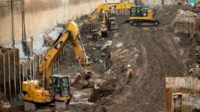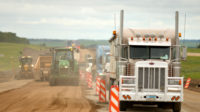Spending on nonresidential construction has grown significantly since the start of the COVID-19 pandemic, but inflation has limited the impact of that spending for the industry, according to Anirban Basu, chief economist for the Associated Builders and Contractors.
Speaking on a webinar March 27 about the economic state of the industry, Basu pointed to U.S. Census Bureau data showing that total nonresidential construction spending increased 34.8% from February 2020 to January 2024. However, when adjusting for inflation, he said the increase is closer to about 13%.
“So much of the growth in construction spending has not been because construction firms collectively have been offering more services to users of construction services, but that they’ve been charging more for the services they deliver,” Basu said.
 Chart courtesy of ABC/Sage Policy Group
Chart courtesy of ABC/Sage Policy GroupA lot of that growth has been driven by forces transforming the economy, Basu said. The greatest increase in spending among different construction sectors from the start of the pandemic is a 187.3% rise in manufacturing construction, according to the Census Bureau.
Basu said he was “way too pessimistic last year” in his forecasts, as the economy has avoided entering a recession as he and other economists had said was likely. However, the construction market may still have a tumultuous period. Basu said he believes difficulties obtaining financing may hinder non-public projects, and he highlighted the Architecture Billings Index, which has been below 50, meaning a decline in business, for seven months.
Most contractors polled during the webinar said their leading challenge now remains a shortage of skilled workers. Basu said he expects the shortage will continue.
“With so many mega projects and public infrastructure projects lined up for the next several years, we’re going to have these shortages for a long time to come,” he said.
Some other factors challenging the industry have improved. Supply chains have largely become more dependable since late 2021, Basu said. And funding from spending bills such as the Infrastructure Investment and Jobs Act will continue to push funding for public projects out through 2026.





.png?height=200&t=1671117701&width=200)
Post a comment to this article
Report Abusive Comment